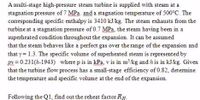
Elements Of Electromagnetics
7th Edition
ISBN: 9780190698614
Author: Sadiku, Matthew N. O.
Publisher: Oxford University Press
expand_more
expand_more
format_list_bulleted
Question

Transcribed Image Text:A multi-stage high-pressure steam turbine is supplied with steam at a
stagnation pressure of 7 MPa. and a stagnation temperature of 500°C. The
corresponding specific enthalpy is 3410 kJ/kg. The steam exhausts from the
turbine at a stagnation pressure of 0.7 MPa, the steam having been in a
superheated condition throughout the expansion. It can be assumed
that the steam behaves like a perfect gas over the range of the expansion and
that y = 1.3. The specific volume of superheated steam is represented by
pv = 0.231(h-1943) where p is in kPa, v is in mkg and h is in kJ/kg. Given
that the turbine flow process has a small-stage efficiency of 0.82, detemine
the temperature and specific volume at the end of the expansion.
Following the Q1, find out the reheat factor RH.
Expert Solution
This question has been solved!
Explore an expertly crafted, step-by-step solution for a thorough understanding of key concepts.
This is a popular solution
Trending nowThis is a popular solution!
Step by stepSolved in 2 steps with 3 images

Knowledge Booster
Similar questions
- Air (MW=29 g/mol) at 115.00 kPa and 285.00 is compressed steadily to 600.0 kPa. The mass flow rate of the air is 2.00 kg/s and a heat loss of 32.1 kW occurs during the process. You may assume that changes in kinetic and potential energy are negligible, the temperature of the surroundings is 25 ∘C, and that the CP of air is 3.5 R. Given the compressor operates with a second law (reversible) efficiency of 0.60,calculate the following. What is the actual work interaction term in kW? What is the actual exit temperature of the air in Celcius?arrow_forwardApply the first law of thermodynamics to nozzle. Assume that the process is reversible adiabatic. Draw the neat sketch and lable inlet and outlet propertiesarrow_forwardWrite the expression of heat for an isothermal reversible expansion of a perfect gas from initial volume V1 to final volume V2.arrow_forward
- Argon is accelerated in a nozzle from 32 m/s at 666 K to 441 m/s and 196 kPa. If the heat loss is equal to 5.1 kJ/kg, determine the gas temperature at outlet in K to 1 decimal place. Take the gas constant as 0.2 (kPa m3)/(kg K) and assume constant specific heats cp=0.5 kJ/(kg K) and cv=0.3 kJ/(kg K).arrow_forwardI need the answer as soon as possiblearrow_forwardFor air properties use online source: https://www.peacesoftware.de/einigewerte/luft_e.html The compressor is operating at steady-state increasing pressure of R-22 refrigerant from 4 bars to 14 bars. Temperature was rising during the process from 12C to 90C. The inlet volumetric flow rate is 1 m3/min and inlet diameter is 0.03m. At the exit the diameter is the same. Heat flow to the surroundings can be neglected. Determine: a.Mass flow rate [kg/s] SHOW AND EXPLAIN ALL STEPS PLEASE thanksarrow_forward
arrow_back_ios
arrow_forward_ios
Recommended textbooks for you
 Elements Of ElectromagneticsMechanical EngineeringISBN:9780190698614Author:Sadiku, Matthew N. O.Publisher:Oxford University Press
Elements Of ElectromagneticsMechanical EngineeringISBN:9780190698614Author:Sadiku, Matthew N. O.Publisher:Oxford University Press Mechanics of Materials (10th Edition)Mechanical EngineeringISBN:9780134319650Author:Russell C. HibbelerPublisher:PEARSON
Mechanics of Materials (10th Edition)Mechanical EngineeringISBN:9780134319650Author:Russell C. HibbelerPublisher:PEARSON Thermodynamics: An Engineering ApproachMechanical EngineeringISBN:9781259822674Author:Yunus A. Cengel Dr., Michael A. BolesPublisher:McGraw-Hill Education
Thermodynamics: An Engineering ApproachMechanical EngineeringISBN:9781259822674Author:Yunus A. Cengel Dr., Michael A. BolesPublisher:McGraw-Hill Education Control Systems EngineeringMechanical EngineeringISBN:9781118170519Author:Norman S. NisePublisher:WILEY
Control Systems EngineeringMechanical EngineeringISBN:9781118170519Author:Norman S. NisePublisher:WILEY Mechanics of Materials (MindTap Course List)Mechanical EngineeringISBN:9781337093347Author:Barry J. Goodno, James M. GerePublisher:Cengage Learning
Mechanics of Materials (MindTap Course List)Mechanical EngineeringISBN:9781337093347Author:Barry J. Goodno, James M. GerePublisher:Cengage Learning Engineering Mechanics: StaticsMechanical EngineeringISBN:9781118807330Author:James L. Meriam, L. G. Kraige, J. N. BoltonPublisher:WILEY
Engineering Mechanics: StaticsMechanical EngineeringISBN:9781118807330Author:James L. Meriam, L. G. Kraige, J. N. BoltonPublisher:WILEY

Elements Of Electromagnetics
Mechanical Engineering
ISBN:9780190698614
Author:Sadiku, Matthew N. O.
Publisher:Oxford University Press

Mechanics of Materials (10th Edition)
Mechanical Engineering
ISBN:9780134319650
Author:Russell C. Hibbeler
Publisher:PEARSON

Thermodynamics: An Engineering Approach
Mechanical Engineering
ISBN:9781259822674
Author:Yunus A. Cengel Dr., Michael A. Boles
Publisher:McGraw-Hill Education

Control Systems Engineering
Mechanical Engineering
ISBN:9781118170519
Author:Norman S. Nise
Publisher:WILEY

Mechanics of Materials (MindTap Course List)
Mechanical Engineering
ISBN:9781337093347
Author:Barry J. Goodno, James M. Gere
Publisher:Cengage Learning

Engineering Mechanics: Statics
Mechanical Engineering
ISBN:9781118807330
Author:James L. Meriam, L. G. Kraige, J. N. Bolton
Publisher:WILEY